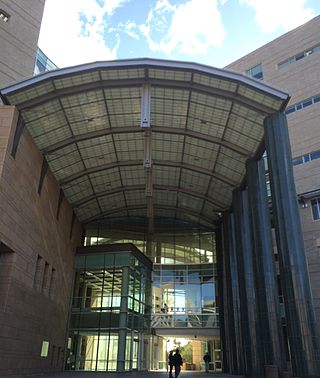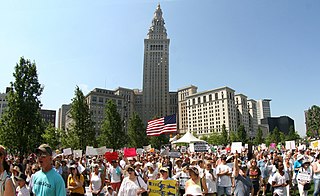U.S. Immigration and Customs Enforcement is a federal law enforcement agency under the U.S. Department of Homeland Security. ICE's stated mission is to protect the United States from cross-border crime and undocumented immigration that threaten national security and public safety.
Illegal immigration, or unauthorized immigration, occurs when foreign nationals, known as aliens, violate US immigration laws by entering the United States unlawfully, or by lawfully entering but then remaining after the expiration of their visas, parole or temporary protected status.

A sanctuary city is a municipality that limits or denies its cooperation with the national government in enforcing immigration law.

The United States government holds tens of thousands of immigrants in detention under the control of Customs and Border Protection and the Immigration and Customs Enforcement (ICE).

The 2014 American immigration crisis was a surge in unaccompanied children and women from the Northern Triangle of Central America (NTCA) seeking entrance to the United States in 2014. According to U.S. law, an unaccompanied alien child refers to a person under 18 years of age, who has no lawful immigration status in the U.S., and who does not have a legal guardian to provide physical custody and care.

Deportation and removal from the United States occurs when the U.S. government orders a person to leave the country. In fiscal year 2014, Immigration and Customs Enforcement conducted 315,943 removals. Criteria for deportations are set out in 8 U.S.C. § 1227.
In United States immigration enforcement, "catch and release" refers to a practice of releasing a migrant to the community while he or she awaits hearings in immigration court, as an alternative to holding them in immigration detention. The migrants whom U.S. immigration enforcement agencies have allowed to remain in the community pending immigrant hearings have been those deemed low risk, such as children, families, and those seeking asylum.

Operation Streamline is a joint initiative of the Department of Homeland Security and Department of Justice in the United States, started in 2005, that adopts a "zero-tolerance" approach to unauthorized border-crossing by criminally prosecuting those perpetrating it. Up to 70 people are tried at the same time, sometimes wearing shackles in the courtroom. Entering without inspection is a misdemeanor, and re-entering after deportation is a felony.

A migrant crisis is a difficult or dangerous situation that arises due to the movements of large groups of immigrants in the receiving state. Migrants are often escaping from conditions which negatively affected them in the country of origin (departure). The "crisis" is not the amount of refugees, but the system's failure to respond in an orderly way to the government's legal obligations towards them. Some notable crises are; European migrant crisis, English Channel migrant crisis and World War II evacuation and expulsion.

Immigration policy, including illegal immigration to the United States, was a signature issue of former U.S. president Donald Trump's presidential campaign, and his proposed reforms and remarks about this issue generated much publicity. Trump has repeatedly said that illegal immigrants are criminals.

The family separation policy under the first Trump administration was a controversial immigration enforcement strategy implemented in the United States from 2017 to 2018, aimed at deterring illegal immigration by separating migrant children from their parents or guardians. The policy, presented to the public as a "zero tolerance" approach, was intended to encourage tougher legislation and discourage unauthorized crossings. In some cases, families following the legal procedure to apply for asylum at official border crossings were also separated. Under the policy, federal authorities separated children and infants from parents or guardians with whom they had entered the US. The adults were prosecuted and held in federal jails or deported, and the children were placed under the supervision of the US Department of Health and Human Services (HHS). Prior to their transfer to HHS, some children spent three weeks or more in overcrowded border control centers, where they reported minimal food, no access to clean clothes or bathing facilities, and no adult caretakers; girls as young as ten were taking care of younger children.

Protests against the Trump administration family separation policy are a reaction to the Trump administration policy of separating children from their parents or guardians who crossed the U.S. border either illegally or to request asylum, jailing the adults and locating the minors at separate facilities under the care of the Department of Health and Human Services.
Family detention is the detention of multiple family members together in an immigration detention context. In the U.S. they are referred to as family detention camps,family detention centers, or family detention facilities.

The Trump administration has detained migrants attempting to enter the United States at the United States–Mexico border. Government reports from the Department of Homeland Security Office of Inspector General in May 2019 and July 2019 found that migrants had been detained under conditions that failed federal standards. These conditions have included prolonged detention, overcrowding, and poor hygiene and food standards.
Remain in Mexico is a United States immigration policy originally implemented in January 2019 under the administration of President Donald Trump, affecting immigration across the border with Mexico. Administered by the Department of Homeland Security, it requires migrants seeking asylum to remain in Mexico until their US immigration court date.
Federal policy oversees and regulates immigration to the United States and citizenship of the United States. The United States Congress has authority over immigration policy in the United States, and it delegates enforcement to the Department of Homeland Security. Historically, the United States went through a period of loose immigration policy in the early-19th century followed by a period of strict immigration policy in the late-19th and early-20th centuries. Policy areas related to the immigration process include visa policy, asylum policy, and naturalization policy. Policy areas related to illegal immigration include deferral policy and removal policy.

The immigration policy of American President Joseph Biden initially focused on reversing many of the immigration policies of the previous Trump administration, before implementing stricter enforcement mechanisms later in his term.

A Title 42 expulsion is the removal by the U.S. government of a person who had recently been in a country where a communicable disease was present. The extent of authority for contagion-related expulsions is set out by law in 42 U.S.C. § 265. During the COVID-19 pandemic, the Centers for Disease Control and Prevention (CDC) under the Trump administration used this provision to generally block land entry for many migrants. This practice was initially continued by the Biden administration before the program was terminated with the end of the COVID-19 national emergency on May 12, 2023. Title 42 of the United States Code includes numerous sections dealing with public health, social welfare, and civil rights, but, in the context of immigration, the phrase "Title 42" came to be used to refer specifically to expulsions under section 265.

Operation Lone Star (OLS) is a joint operation between the Texas Department of Public Safety and the Texas Military Department along the United States–Mexico border in southern Texas. The operation started in 2021 and is ongoing. According to Texas Governor Greg Abbott, the operation is intended to counter a rise in illegal immigration, the illegal drug trade, and human smuggling. Between fiscal year 2020 and fiscal year 2021, migrant apprehensions had risen 278% along the US–Mexico border. According to the governor's office, OLS has resulted in 513,700 migrant apprehensions, 44,000 criminal arrests, and 489 million doses of fentanyl seized. As of April 2022, OLS was spending approximately $2.5 million per week and was expected to cost approximately $2 billion per year. Approximately 10,000 National Guard members were deployed in support of OLS at the height of the operation, with around 6,000 deployed as of November 2022. One year after the start of Operation Lone Star, Texas saw a 9% increase in migrant encounters along its border with Mexico, compared to a 62% increase in Arizona, California, and New Mexico along their respective borders with Mexico. As of June 2024, the Department of Public Safety has estimated a 74% drop in illegal border crossings since the start of OLS.
A Proclamation on Securing the Border is a presidential directive signed by U.S. president Joe Biden. Signed on June 4, 2024, the executive order allows the president to restrict the Mexico–United States border. The proclamation implements a limit on illegal immigration, effective June 5.















